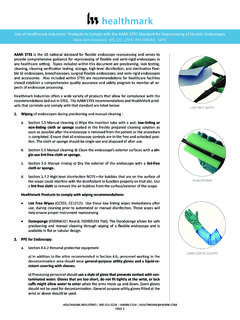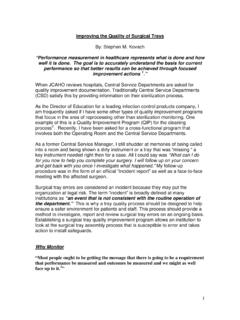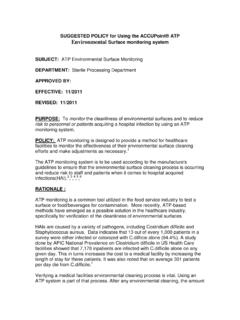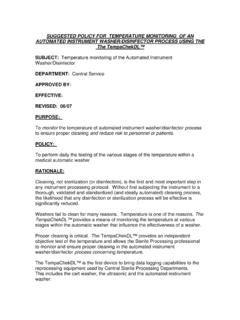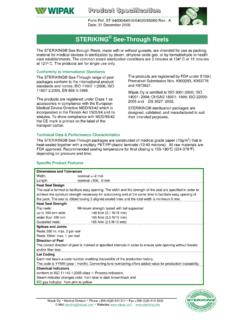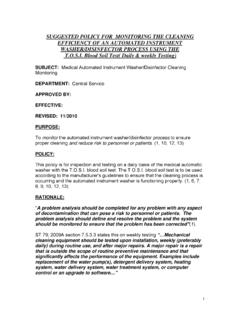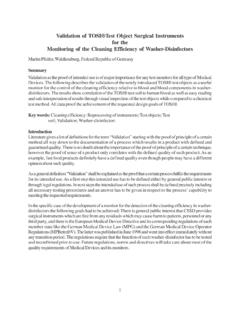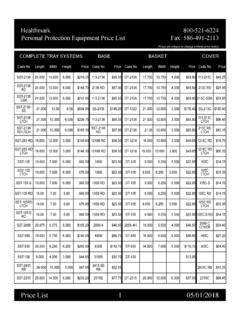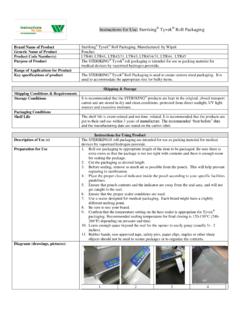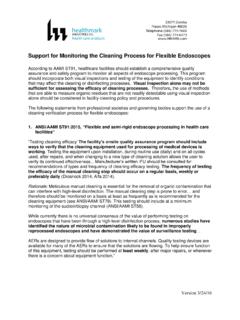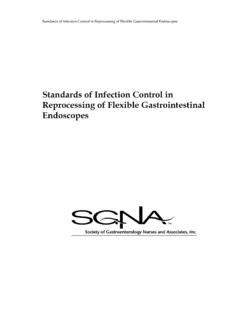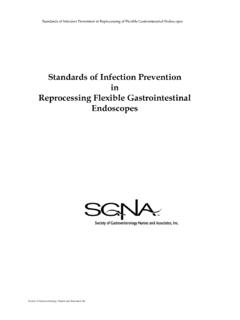Transcription of SUBJECT: Detection of protein residue inside the channels ...
1 SUBJECT: Detection of protein residue inside the channels of an endoscope and on surfaces DEPARTMENT: Central Service/ Endoscopy APPROVED BY: EFFECTIVE: REVISED: 8/2015. PURPOSE: To detect protein residue inside various channels like the biopsy channel of an endoscope in order to help ensure proper cleaning and reduce risk to personnel and patients. POLICY: The endocheck -EDP test detects protein residues inside the various channels of an endoscope and on its surfaces. The random testing of endoscope channels such as the biopsy channel should be performed according to medical facilities guidelines to ensure that the cleaning process is being performed properly. RATIONALE: "A problem analysis should be completed for any problem with any aspect of decontamination that can pose a risk to personnel or patients. The problem analysis should define and resolve the problem and the system should be monitored to ensure that the problem has been corrected".
2 1. One such problem is protein residual inside the biopsy channel of an endoscope. To ensure that the staff is properly cleaning any flexible endoscope verification of that process needs to take place. AAMI ST 91 states the following in support of monitoring the cleaning process Cleaning verification tests are performed following cleaning and are used to verify the effectiveness of a cleaning process to remove or reduce to an acceptable level the organic soil and microbial contamination that occurs during the use of an endoscope 2. Detection of protein residues inside the biopsy channel of a scope is very important and distinguishing between protein and other types of residues can be very confusing. Finding any protein residue left inside a biopsy channel that has been cleaned is never good and the implications are even more serious. There has been a growing concern about the effectiveness of decontamination technique for reusable medical instrumentation in healthcare facilities.
3 Studies have shown the ability of sterilization technologies, which under normal conditions; achieve acceptable sterility assurance levels, to be greatly impaired 1. by the presence of residual soil containing serum and salt3. Residual organic debris on processed surgical instruments is a concern and visual inspection is not a 100% accurate4 . Current data (Alfa, et al., 2002) indicate that for flexible endoscopes that have been cleaned after use on patients, the average levels of soil markers are as follows: protein , < g/cm2; carbohydrate, < g/cm2; hemoglobin, < g/cm2; sodium ion, < 1 mole/cm2; and endotoxin, < EU/cm2 in the biopsy/suction channel ( ST 79- - Section - Markers).. Why test for protein ? Because the three most predominant contaminants that are the main components of bodily fluids are protein , hemoglobin, and carbohydrates. protein has numerous sources in clinical soil and is typically the primary marker for reusable cleaning validations by medical device manufactures.
4 If protein is left on a surface it means something5. So testing for this marker if left on an item is important, it is a sign if something is It is important to test any surface that is suspect of protein residue . The danger of unclean surfaces in a hospital or of handling instruments contaminated with protein is obvious in this age of hepatitis, CJD, and HIV. The procedures for sterilizing and High Level Disinfection (HLD) of medical devices (like flexible endoscopes) are based on years of scientific testing. If medical devices are not clean, the procedures are ineffective. Dried protein on any medical device can be hazardous to the employees of the hospital and to the next patient upon which the medical device are used. The ProCheckII Test is based on the formation of a protein -dye complex. This reaction detects the protein chain itself; therefore it can still show chemically altered and denatured protein . This is mandatory for the Detection of residue after chemical disinfection processes.
5 The Detection limit of 1 g is low enough and necessary for a safe test result. Medical devices should be completely free of residue ! Compared to other tests like the OPA method, the Ninhydrin test or the Biuret test, the ProCheckII Test is more sensitive and selective in performance and is considered according to the EN ISO 15883 standards. 7. The use of a protein type test is supported in the AORN Recommended Practices and Guidelines as well as AAMI ST 79. Periodic testing provides an opportunity to evaluate the performance of personnel. Manual cleaning is a learned skill and subject to human error. New instruments can pose unique challenges when cleaning. protein indicators are commercially available to assist with this evaluation 8. 2. protein test, pyromol-test swab device, immerse in reagent, and assess for color change . applicable to protein soiled surfaces such as instruments and instruments with lumens rust or non-proteinous discoloration on the swab will interfere with the color change.
6 9. A quality improvement system that monitors the cleaning process is an important function of any Infection Control program. As noted in Annex D in AAMI ST 79..for verification of routine cleaning processes, users should incorporate test methods that verify the functionality of the automated washer (if used) and the cleanliness of specific devices after manual or automated cleaning is completed. These verification tests are part of continuous quality improvement to demonstrate continued compliance with cleaning benchmarks, once these benchmarks have been defined .. Testing any medical device or surface that is suspect of protein residue is important. The risk of not only having the biopsy channel cleaned but also any surface properly cleaned is significant especially when handling instruments contaminated with protein , blood and other patient secretions of patients. Having a quality system to help monitor the channel especially the biopsy channel of an endoscope that you might suspect has not been cleaned properly and have blood/ protein residue is an important function of any Infection Control program.
7 Testing these channels with the endocheck -EDP and recording results in a log is one such program. The use of the endocheck -EDP is an excellent tool to use for training of new employees as well as establishing a Quality Improvement Program for checking whether cleaning is being performed properly. The frequency of testing ( after each cleaning, daily, weekly, etc.) of the endoscopes various channels like the biopsy channels should be done at least weekly. All results should be documented and shared with the staff 3. PROCEDURE: Instructions for testing endoscopes for protein using endocheck -EDP. protein residue Instrument Assay: A test kit for the Detection of protein residue in flexible endoscopes. 10. Gloves must be worn throughout the test procedure to avoid contamination of the test. 1. The biopsy channel of a flexible endoscope is a critical component to be tested. This is performed after cleaning and before the sterilization/disinfection process.
8 A. Place the vial into the holder provided unscrew cap. Make sure to moisten the cotton swab with a drop of clean water before testing the channel of the scope. Do not use chlorinated water. b. Insert the swab end of the wire into the scope/biopsy channel. Push it all the way through one (1) time. c. Place the swab into the vial. Cut the swab end off into the vial with the supplied scissors. Do not touch swab. Place cap back on the vial and tighten and shake at least 5 times. If protein is present, color change of the liquid and/or on the swab to blue-green will occur. In case of soluble proteins, there will be an immediate color change. In the case of denatured proteins (often the case with instruments subjected to reprocessing) color change can take up to 5 minutes. d. To remove the remaining segment of the endocheck , pull the wire out from the distal tip. Dispose in trash according to facility policy e. Check the liquid and the swab for a color change to blue-green within 5 minutes and no longer.
9 If no color changes within 5 minutes the test is negative for protein . Record the result for quality assurance. 1 g of denatured protein residue on the swab will develop a small blue-green spot. In the presence of large amounts of soluble protein the whole indicator solution will change blue-green. NOTE: Positive controls can be used for verification and training purposes. 4. PRINCIPLE. The formation of a protein -dye complex is used to detect small protein residue by means of a colour change on a swab. Swabbing is the preferred sampling technique in order to also detect insoluble residue . RANGE OF APPLICATION. For Detection of protein residues on surfaces. Examples: Chamber walls of WD s, Ultrasonic cleaner, work bench, surfaces of surgical instruments or inside channels of endoscopes. Test for residues of protein based test soils. MEASURING RANGE. The test kit can detect down g of insoluble protein by showing a blue-green spot.
10 INTERFERENCES. Contact to alkaline substances (larger amount of alkaline detergent) can trigger colour change. Quaternary ammonium salts (used in some disinfectants) will give a false positive result. Contact to bare hands can transfer protein particles onto the swab and may give a false positive result. CONTENTS OF PACKAGE. 12 X single use tests for Detection of protein residue on surfaces and inside hollow instruments like flexible endoscope. STORAGE: Store EDP in a cool place at 2 C- 25 C. Keep away from light and heat and do not freeze. SHELF LIFE: See imprint on packaging RESPONSIBILITY: The Central Service manager is responsible for training, assuring initiation, completion and analysis of the monitoring assessment activity for testing of blood residuals on various surfaces. 5. Sample Competency for Tests Endoscopes for protein residue Name: _____. Competency Statement: Complies with policy and procedure for cleaning and testing endoscopes (biopsy channels ).
